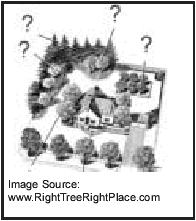 Few Missourians will ever
forget the weather conditions
at this time two years
ago — a large portion of the
state covered in ice, and the
shotgun-like snap of hundreds
of branches as they
fell from its weight.
Few Missourians will ever
forget the weather conditions
at this time two years
ago — a large portion of the
state covered in ice, and the
shotgun-like snap of hundreds
of branches as they
fell from its weight.
Following the intense ice storm that battered much of the state in January of 2002, a concerned public/private coalition developed “The Right Tree in the Right Place,” an initiative to address tree replacement. The coalition offers advice on what trees to plant — and how and where — to ensure fewer future growth problems.
The “Right Tree in the Right Place” project educates the public through an interactive web site; brochures and advertisements about tree selection, planting and care; and educational programs for neighborhood associations and groups.
The web site, www.RightTreeRightPlace.com, is an excellent resource for homeowners and others to use when making tree planting decisions and performing tree maintenance work. Though it was developed in response to an ice storm, the site holds significant value for people replanting trees after the May 2003 tornadoes and those simply adding trees to their yards.
The coalition has received numerous media coverage opportunities and continues to generate awareness for the project. Three special inserts in the largely-circulated Kansas City Star newspaper have promoted “The Right Tree in the Right Place,” and a public service announcement promoting the web site has aired more than 1,500 times. Coalition partners have distributed a tree policy guide to city administrators. Educational bookmarks and brochures serve as public handouts, and several programs and displays have been completed through in-house staff time and resources (such as printing and web site management) from the coalition partners. The National Arbor Day Foundation recently rewarded these efforts with an award for Advertising and Public Relations, to be presented in May. Participants in the coalition include the Missouri Department of Conservation, Kansas Forest Service, Mid-America Regional Council, Bridging the Gap, The Kansas City Star, Time Warner Cable, Kansas City Power and Light, Powell Gardens, the Kansas Nursery and Landscape Association and the Missouri Landscape and Nursery Association. Numerous communities are also participating by sharing information with their citizens. Visit www.RightTreeRightPlace.com for additional information, helpful links and resources.
Storm Damage: Can This Tree Be Saved?
(source: www.RightTreeRightPlace.com)

It’s a Keeper (20% or less loss):
When there is only slight damage to
your tree, you should remove damaged
limbs and let the tree begin the
process of repairing itself. Do not
paint over wounds or wrap wire or
strapping of any sort around a damaged
branch to let it “heal”. Use
good pruning techniques instead.
 Wait and See (20-40% loss):
Wait and See (20-40% loss):
If several limbs are broken, you
should remove damaged limbs and
evaluate the tree over time. These
trees may recover, depending on
environment, species, and damage
location on the tree. However, if the
tree is near a house or any aboveground
utility line, contact that utility
and have them evaluate the situation. Do not endanger
yourself by doing trimming close to an electrical
line.
 Say Goodbye (50% or more
loss):
Say Goodbye (50% or more
loss):
When there are fewer
branches on your tree than off,
you need to consider removing
the tree. It is not possible to
have a tree recover completely
from this type of loss. If they are
not removed, it is very likely they will die eventually
from disease or insect infestations. If they do live, they
will continue to have structural problems which could
pose a hazard to anything nearby. Hiring a professional
tree care company is the best option in this situation.